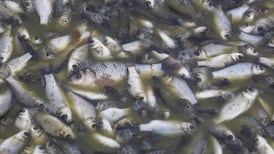`Hibernaculum" is one of zoology's more satisfying words. It suggests a cosy armchair in the library of a gentlemen's club, or perhaps a chamber deep within a pyramid: somewhere safe and silent.
It is, quite guessably, the domicile in which an animal hibernates: a cave for a bear, a nest of leaves for a hedgehog, the muddy bottom of a pond for a frog (a males-only club, again). The sett for a badger? No: feeling a bit dozy and disinclined in winter is not the same as hibernation.
The true condition is actually quite rare in Irish wildlife. Hibernation is a profoundly different state of being, in which pulse and breathing become almost imperceptible and body temperature falls close to that of the surrounding air. Metabolism barely ticks over, and the energy the animal uses is like a tiny pilot-flame, drawing quietly on reserves of fat.
The bat I visited briefly the other afternoon certainly seemed deeply oblivious: a neat little bundle wrapped in its wings in darkness and hanging from a spur of rock by 10 tiny toes. If I had waited for half-an-hour, it might have taken one small breath. As it was, I swung the torch away before the bat could even think of stirring. Bats do surface briefly in winter, when their body needs a drink, but a forced arousal can use energy sufficient for 50 days of hibernation.
And this one was precious - a tiny and delicate lesser horseshoe, Rhinolophus hipposideros, weighing no more than 9 grams. Deep in a passage of an old iron mine, in a hill overlooking Lough Corrib, it was right at the northern edge of its range. Further south, on the Continent, huge populations of this bat have been reduced to near-extinction, so that its roosts in the west of Ireland are now its last stronghold in Europe.
My guide through the dark was Dr Kate McAney, whose work for the Vincent Wildlife Trust has focused on this particularly vulnerable species. While other bats tuck themselves away in winter into crevices and hidey-holes, the lesser horseshoes insist on behaving like hibernating bats as most people imagine them - hanging off the ceiling, one by one, like little fruit wrapped in silk. This can make them a special target for disturbance.
Duchas and the Vincent Wildlife Trust have been working side by side to help protect their refuges, putting grilles across cave entrances, reroofing old buildings and even creating new hibernacula from derelict stone structures. The attentions of casual vandals, wrenching at grilles and locks, are a frequent frustration.
Five of Ireland's nine kinds of bats use underground spaces - not just for hibernation, but for mating and other sorts of socialising, and sometimes as night roosts in summer. A good deal of work has been done on caves, but relatively little on the importance to bats of Ireland's old, abandoned mines. Bats have been found in or around mines in Antrim, Galway, Cork and Wicklow - Daubenton's and Natterer's bats, along with the lesser horseshoes.
Hanging from a roof or wall, or tucked into a crack deep inside a mine might seem a safe enough choice, but new threats materialise as time passes: people decide to block a mine up as dangerous - or, on the contrary, decide to open it as a tourist attraction. A whole conference on "Mine Heritage and Tourism: A Hidden Resource" was held in Co Tipperary last November.
In a recent special issue of the Royal Irish Academy journal, Biology and Environment, on the ecology of old mine sites, Kate McAney listed some of the rules for leaving hibernating bats in peace: don't organise visits in winter; don't handle the bats or knock them off the roof with your helmet; don't shine torches on them, take flash photographs, make a lot of noise, smoke, or use carbide lamps.
In the mine above Corrib the other evening, it took her more than an hour, searching every square foot of the passages, to find 10 lesser horseshoes. Such sparse but precious outliers are part of a total of 12,000 (or so) in the Irish population. For creatures that small, it's not much.
Meanwhile, a radio-tracking study of another Irish bat - the big, fast-flying Leisler's that feeds predominantly on dung-flies - has located another natural habitat which may be a valuable hibernaculum: the hollow tree.
In the first Irish experiment of its kind, funded by the Heritage Council, Dr Caroline Shiel spent two long summers tracking the movements of 35 radio-tagged bats from two nursery colonies in Co Wexford, one in the attic of a roadside cottage, the other in a disused chimney. They commuted directly to their foraging-grounds, and Dr Shiel followed them individually by car, sometimes for up to 13 kilometres from the roost and often at speeds above 40 kph. Until this study, nothing was known of the commuting habits of Leisler's, a rare bat now in most of Europe but common in Ireland's fly-rich cattle country.
An incidental discovery was that the bats would sometimes use hollow trees as temporary roosts away from home. Since there has never been a record of Leisler's roosting in an underground site in Ireland, these cavities may be where they spend the winter.
Hollow trees are at a premium in Ireland, where an old tree is quickly disparaged as unsafe, and needless felling is common. And, as Caroline Shiel reminds us, we have no woodpeckers to open up cavities in younger trees. The case for conserving our older trees (the dead ones, too, for all the insects that depend on them) grows more compelling the more we learn of their ecology.








